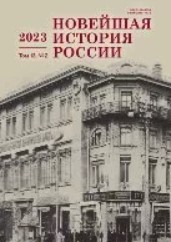Влияние советской религиозной политики на положение православных общин в Западной Сибири в конце 1940-х — начале 1950-х гг.
The Influence of Soviet Religious Policy on the Orthodox Communities in Western Siberia in the Late 1940s — Early 1950s
Author(s): Peter Konstantinovich Dashkovskiy, Natalia Petrovna ZibertSubject(s): History of Church(es), Government/Political systems, Politics and religion, WW II and following years (1940 - 1949), Post-War period (1950 - 1989), History of Communism, Eastern Orthodoxy
Published by: Издательство Исторического факультета СПбГУ
Keywords: USSR; Western Siberia; religious communities; Council for the Affairs of the Russian Orthodox Church; Russian Orthodox Church; late Stalinism;
Summary/Abstract: Based on the documents of the State Archive of the Altai Republic, the State Archive of the Novosibirsk Region, the State Archive of the Russian Federation, the Historical Archive of the Omsk Region, the article examines the implementation of the confessional policy of the Soviet state in Western Siberia in the first post-war years. Since the end of 1947, the state’s confessional policy had been gradually changing, as a result of which the religious communities of the country were increasingly subjected to administrative pressure from the Soviet authorities. During the registration procedure, believers faced numerous difficulties due to the unwillingness of local authorities to have operating parishes on their territory. The Orthodox communities of Western Siberia were no exception. In the territory under consideration in 1948–1953, multiple facts of administrative harassment by regional authorities were recorded, which led to low church attendance and an increase in the number of religious rites performed by believers at home. Often religious communities were placed in conditions under which the further functioning of the parish became impossible. Therefore, believers were forced to stop using houses of prayers. In addition, in the late 1940s — early 1950s, the functioning of churches was influenced by the processes of migration of rural population to the city, as well as by social and socio-cultural transformations in Soviet villages, as a result of which the population tried to avoid public visits to religious sites. The above factors led to an increase in the activities of unregistered ministers of worship, around whom a permanent circle of believers was formed. This, in turn, provoked the emergence of a large number of illegally functioning religious groups whose activities could hardly be controlled by the Soviet authorities in Western Siberia.
Journal: Новейшая история России
- Issue Year: 13/2023
- Issue No: 43
- Page Range: 470-481
- Page Count: 12
- Language: Russian

